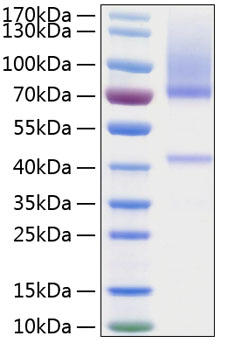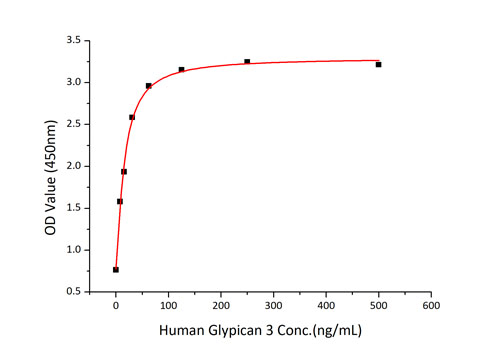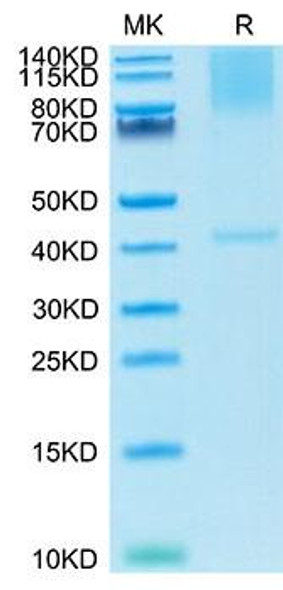Description
Recombinant Human Glypican-3/GPC3 Protein
The Recombinant Human Glypican-3/GPC3 Protein is a biologically active recombinant protein that plays a significant role in various cellular processes and signaling pathways in human biology. This protein is widely employed in immunological research, cell biology studies, protein-protein interaction analyses, and therapeutic development, providing researchers with a reliable tool for investigating Glypican-3/GPC3 function and its implications in health and disease.
This product (SKU: RPCB0230) is produced using HEK293 cells and features a C-His tag for convenient detection and purification. The protein exhibits a calculated molecular weight of 61.62 kDa with an observed molecular weight of 40-44, 66-115 kDa. under denaturing conditions, achieving ≥ 90 % as determined by SDS-PAGE.. Functional bioactivity has been validated through rigorous quality control assays, confirming its suitability for demanding research applications.
Key Features
| High Purity by Affinity Chromatography | |
| Mammalian & Bacterial Expression Systems | |
| High lot-to-lot consistency via strict QC |
| Product Name: | Recombinant Human Glypican-3/GPC3 Protein |
| SKU: | RPCB0230 |
| Size: | 10 μg , 20 μg , 50 μg , 100 μg |
| Reactivity: | Human |
| Synonyms: | GPC3, DGSX, GTR2-2, MXR7, OCI-5, SDYS, SGB, SGBS, SGBS1, GTR2-2, MXR7, OCI-5, SDYS, SGB, SGBS, SGBS1, glypican-3 |
| Tag: | C-His |
| Expression Host: | HEK293 cells |
| Calculated MW: | 61.62 kDa |
| Observed MW: | 40-44, 66-115 kDa. |
| Gene ID: | 2719 |
| Protein Description: | High quality, high purity and low endotoxin recombinant Recombinant Human Glypican-3/GPC3 Protein (RPCB0230), tested reactivity in HEK293 cells and has been validated in SDS-PAGE.100% guaranteed. |
| Endotoxin: | < 0.1 EU/μg of the protein by LAL method. |
| Purity: | ≥ 90 % as determined by SDS-PAGE. |
| Formulation: | Lyophilized from a 0.22 μm filtered solution of PBS, pH 7.4.Contact us for customized product form or formulation. |
| Bio-Activity: | Measured by its binding ability in a functional ELISA. Immobilized Human FGF2 at 0.5 μg/mL (100 μL/well) can bind Human GPC3 with a linear range of 7-20 ng/mL. |
| Reconstitution: | Centrifuge the vial before opening. Reconstitute to a concentration of 0.1-0.5 mg/mL in sterile distilled water. Avoid vortex or vigorously pipetting the protein. For long term storage, it is recommended to add a carrier protein or stablizer (e.g. 0.1% BSA, 5% HSA, 10% FBS or 5% Trehalose), and aliquot the reconstituted protein solution to minimize free-thaw cycles. |
| Storage: | Store at -20℃.Store the lyophilized protein at -20℃ to -80 ℃ up to 1 year from the date of receipt. After reconstitution, the protein solution is stable at -20℃ for 3 months, at 2-8℃ for up to 1 week. |
Glypican-3, also known as Intestinal protein OCI-5, GPC3, and OCI5, is a member of the glypican family. It belongs to the glypican family and is highly expressed in the lung, liver, and kidney. It is a heparan sulfate proteoglycan, which is overexpressed in various neoplasms such as hepatocellular carcinoma, malignant melanoma, and testicular yolk sac tumor, and plays an important role in cell growth and differentiation. GPC3 function is tissue-dependent. In some tissues, GPC3 acts as a tumor suppressor gene, whereas in others, it acts as an oncofetal protein. Studies have shown that GPC3 is a reliable marker for hepatocellular carcinoma. The sensitivity and specificity exceed both alpha-fetoprotein and hepatocyte-paraffin1. GPC3 immunohistochemistry can aid in the differentiation of testicular germ cell tumors, being expressed in all yolk sac tumors but not in seminomas. GPC3 expression has also been identified in some squamous cell carcinomas of the lung and clear cell carcinomas of the ovary.








